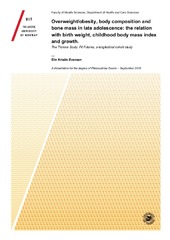Overweight/obesity, body composition and bone mass in late adolescence: the relation with birth weight, childhood body mass index and growth. The Tromsø Study: Fit Futures, a longitudinal cohort study
Permanent lenke
https://hdl.handle.net/10037/14589Åpne
Dato
2019-02-07Type
Doctoral thesisDoktorgradsavhandling
Forfatter
Evensen, Elin KristinSammendrag
Methods: The Tromsø Study, Fit Futures (TFF) is a population-based cohort study with participants from Tromsø and neighbouring municipalities. Two waves were conducted in 2010-2011 (TFF1) and 2012-2013 (TFF2). Data from a representative sample of 961 adolescents (48% girls) from TFF1, of which 659 had follow-up data from TFF2, formed the basis for this thesis. Longitudinal anthropometric data were retrospectively obtained from the Medical Birth Registry of Norway and childhood health records at 2-4 and 5-7 years. Body composition (fat mass and fat-free mass) and bone mass and bone density were measured by dual-energy X-ray absorptiometry at 15-17 and 18-20 years of age. In addition, height, weight and waist circumference was obtained. Participants were classified into BMI categories: underweight, normal weight, overweight and obese, according to the International Obesity Task Force age- and sex-specific cut-off values for children 2-18 years of age.
Results: The prevalence of overweight including obesity increased with age and 21% of girls and 28% of boys were overweight/obese at 18-20 years of age. There was a modest association between birth weight and overweight/obesity at 15-20 years of age, and birth weight was significantly associated with higher fat-free mass as well as bone mass in adolescence. The degree of tracking of BMI from 2-4 and 5-7 years of age up to 15-20 years of age was moderate, with stronger associations observed for more severe overweight and obesity. Overweight/obesity at 6.0 and 16.5 years of age as well as greater BMI gain between 6.0 and 16.5 years of age, were strong predictors of higher fat mass index (kg/m2) and central overweight/obesity as well as higher fat-free mass index (kg/m2) at 15-20 years of age. Compared to normal weight, overweight/obesity at 6.0 and 16.5 years of age revealed significantly higher levels of bone mass and bone density at total hip and total body, but underweight was consistently associated with lower bone mass and bone density at 15-20 years of age.
Conclusion: We found a modest positive association between birth weight and body composition and bone mass at 15-20 years of age. Compared to birth weight, a high childhood BMI as well as childhood growth rate had a stronger influence on bone mass and bone density in adolescence. Greater BMI gain between 6.0 and 16.5 years of age were most strongly linked to adiposity and central overweight/obesity in adolescence. Early identification of children at risk of adverse levels of adiposity is possible and preventive efforts should focus on a healthy weight development. Both early childhood and adolescence are important ages for preventive efforts.
Har del(er)
Paper I: Evensen, E., Emaus, N., Kokkvoll, A., Wilsgaard, T., Furberg, A-S. & Skeie, G. (2017). The relation between birthweight, childhood body mass index, and overweight and obesity in late adolescence: a longitudinal cohort study from Norway, The Tromsø Study, Fit Futures. BMJ Open, 7: e015576. Also available at http://hdl.handle.net/10037/11430.
Paper II: Evensen, E., Emaus, N., Furberg, A-S, Kokkvoll, A, Wells, J, Wilsgaard, T. … Skeie, G. (2018). Adolescent body composition, and associations with body size and growth from birth to late adolescence. The Tromsø Study: Fit Futures – a Norwegian longitudinal cohort study. (Accepted manuscript). The article is available in the thesis introduction. Published version in Pediatric Obesity, e12492 available at https://doi.org/10.1111/ijpo.12492.
Paper III: Evensen, E., Skeie, G., Wilsgaard, T., Christoffersen, T., Dennison, E., Furberg, A. … Emaus, N. (2018). How is adolescent bone mass and density influenced by early life body size and growth? The Tromsø Study: Fit Futures - a longitudinal cohort study from Norway. JBMR Plus, 2(5), 268-280. Also available at https://doi.org/10.1002/jbm4.10049.
Forlag
UiT The Arctic University of NorwayUiT Norges arktiske universitet
Metadata
Vis full innførselSamlinger
Følgende lisensfil er knyttet til denne innførselen:


 English
English norsk
norsk
